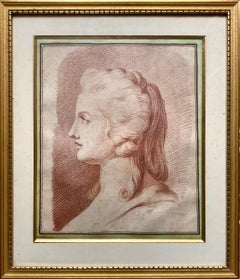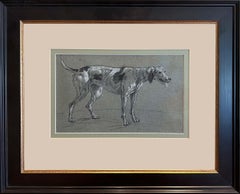18th Century Drawings and Watercolor Paintings
Old Masters 18th Century Drawings and Watercolor Paintings
Pastel, Laid Paper
French School 18th Century Drawings and Watercolor Paintings
Chalk
18th Century Drawings and Watercolor Paintings
Pen
Dutch School 18th Century Drawings and Watercolor Paintings
Paper, Watercolor
Old Masters 18th Century Drawings and Watercolor Paintings
Paper, Chalk
Academic 18th Century Drawings and Watercolor Paintings
Carbon Pencil
Academic 18th Century Drawings and Watercolor Paintings
Pastel
Rococo 18th Century Drawings and Watercolor Paintings
Gouache, Vellum
Academic 18th Century Drawings and Watercolor Paintings
Chalk, Laid Paper
Rococo 18th Century Drawings and Watercolor Paintings
Chalk, Laid Paper
Other Art Style 18th Century Drawings and Watercolor Paintings
Paper, Pencil
Baroque 18th Century Drawings and Watercolor Paintings
Ink, Paper
Old Masters 18th Century Drawings and Watercolor Paintings
Oil, Canvas
French School 18th Century Drawings and Watercolor Paintings
Chalk, Laid Paper
French School 18th Century Drawings and Watercolor Paintings
Handmade Paper, Chalk
Victorian 18th Century Drawings and Watercolor Paintings
Paper, Pencil, Charcoal
18th Century Drawings and Watercolor Paintings
Watercolor, Engraving
Other Art Style 18th Century Drawings and Watercolor Paintings
Paper, Pencil
Other Art Style 18th Century Drawings and Watercolor Paintings
Paper, Color Pencil
Other Art Style 18th Century Drawings and Watercolor Paintings
Paper, Ink, Watercolor
Rajput 18th Century Drawings and Watercolor Paintings
Gold
Rajput 18th Century Drawings and Watercolor Paintings
Gold
Rajput 18th Century Drawings and Watercolor Paintings
Gold
Rajput 18th Century Drawings and Watercolor Paintings
Gold
Rajput 18th Century Drawings and Watercolor Paintings
Gold
Rajput 18th Century Drawings and Watercolor Paintings
Gold
Rajput 18th Century Drawings and Watercolor Paintings
Gold
Rajput 18th Century Drawings and Watercolor Paintings
Gold
Rajput 18th Century Drawings and Watercolor Paintings
Gold
Rajput 18th Century Drawings and Watercolor Paintings
Gold
Old Masters 18th Century Drawings and Watercolor Paintings
Watercolor, Ink
18th Century Drawings and Watercolor Paintings
Watercolor
Old Masters 18th Century Drawings and Watercolor Paintings
Watercolor, Ink
18th Century Drawings and Watercolor Paintings
Watercolor, Ink
18th Century Drawings and Watercolor Paintings
Watercolor, Ink
Old Masters 18th Century Drawings and Watercolor Paintings
Watercolor, Ink
18th Century Drawings and Watercolor Paintings
Ink
18th Century Drawings and Watercolor Paintings
Watercolor, Ink
Old Masters 18th Century Drawings and Watercolor Paintings
Ink, Watercolor, Archival Paper
Modern 18th Century Drawings and Watercolor Paintings
Watercolor
18th Century Drawings and Watercolor Paintings
Watercolor
18th Century Drawings and Watercolor Paintings
Watercolor
English School 18th Century Drawings and Watercolor Paintings
Paper, Pastel
Old Masters 18th Century Drawings and Watercolor Paintings
Pencil
Realist 18th Century Drawings and Watercolor Paintings
Watercolor, Paper
18th Century Drawings and Watercolor Paintings
Watercolor
18th Century Drawings and Watercolor Paintings
Watercolor
18th Century Drawings and Watercolor Paintings
Watercolor
Realist 18th Century Drawings and Watercolor Paintings
Paper, Watercolor
18th Century Drawings and Watercolor Paintings
Watercolor
Old Masters 18th Century Drawings and Watercolor Paintings
Paper, Pencil
18th Century Drawings and Watercolor Paintings
Pen, Ink
18th Century Drawings and Watercolor Paintings
Ink, Pen
Realist 18th Century Drawings and Watercolor Paintings
Watercolor, Paper
18th Century Drawings and Watercolor Paintings
Watercolor
18th Century Drawings and Watercolor Paintings
Watercolor
Renaissance 18th Century Drawings and Watercolor Paintings
Chalk, Paper
Renaissance 18th Century Drawings and Watercolor Paintings
Chalk, Paper
Read More
In This Surreal Painting, the Pink Foot of Patriarchy Squashes a Pumpkin Worshipped by Women
In ‘Gourd,’ Isabel Rock creates a mythic scene that looks fresh and contemporary but feels as old as Eden.
Mid-Century Americans Didn’t Know Antonio Petruccelli’s Name, but They Sure Knew His Art
The New York artist created covers for the nation’s most illustrious magazines. Now, the originals are on display as fine art.
Cecilia Vicuña Merges Politics, Science and Spirituality in Her Poetic Art
The Chilean creator, who has been living in exile in New York for decades, is having a major moment, receiving the biggest exhibitions, commissions and awards an artist could dream of.
Who Are the Most Popular Artists on 1stdibs?
Learn the stories of some of the world's most recognizable artworks and their makers.
Shantell Martin Finds Wonder in Sharing the Creative Process
The visual artist completed a new work in front of a crowd at the 1stdibs Gallery.






